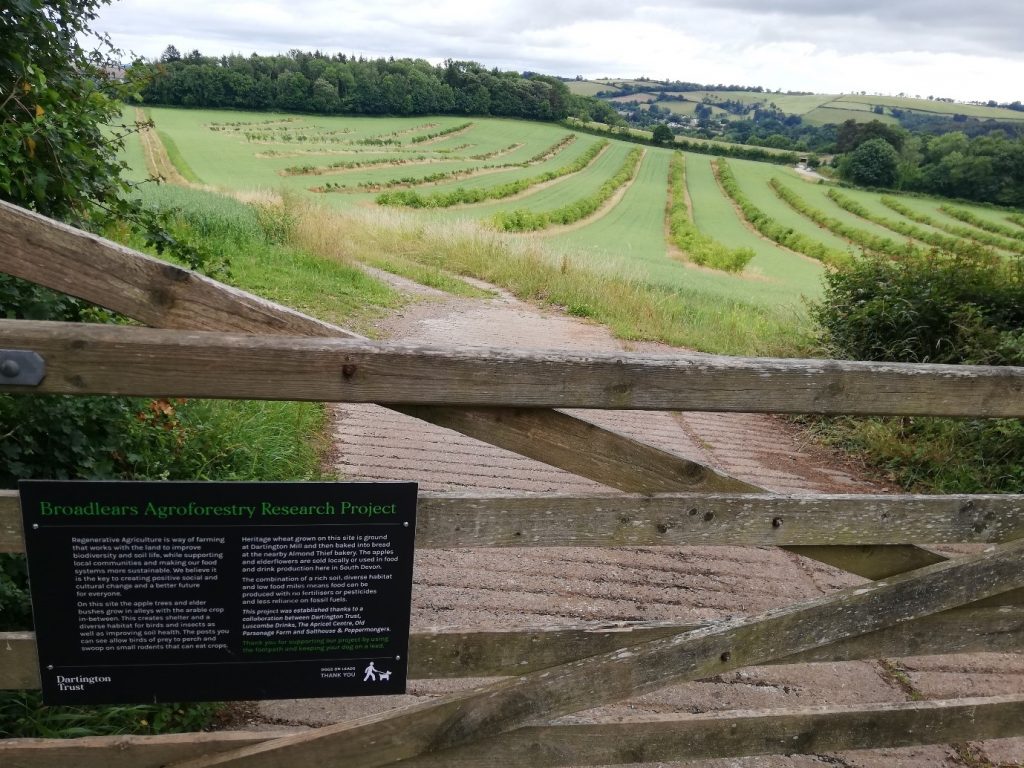
Should we abandon agriculture altogether?
Steffen Hirth, Ulrike Ehgartner, and Ivan Drlička examine the need to create resilient food provision in a net-zero society.
This suggestion may sound mad. If so, this likely comes from an understanding of agriculture as equivalent to the practice of producing food, and to suggest producing no more food would be absurd. That is not what we suggest here, rather the opposite. This contribution calls upon the exploration of agroforestry systems and the environmental and cultural ecosystem services they can provide against the need to create resilient food provision in a net zero society. This includes the benefits of carbon sequestration, biodiversity restoration, recreational and educational benefits, and, last but not least, food production. Polycultural agroforestry, drawing on woody species, other perennials and plant-fungal symbiosis, has serious potential to replace “agriculture” (as we know it), and it is a form of regenerative agroecology that goes beyond more established alternatives such as organic, yet treeless, growing in monoculture.
Without a doubt, agri-food systems in the UK and globally are in crisis and largely unsustainable (e.g. the Independent Review 2020 commissioned by Henry Dimbleby also known as the UK National Food Strategy; for a global perspective see Willett et al. 2019). Changing food systems swiftly and dramatically is essential to enabling lifestyles compatible with the targets of the Paris Agreement. Food provision’s impact on the climate is so significant that, even if all consumption areas that are not food-related (e.g. housing and buildings, mobility and logistics, manufacturing industries, electric energy and heat production) were successfully decarbonised, we would still fail the target of limiting global temperature rise to 1.5°C due to the emissions of an unchanged agri-food system (Clark et al. 2020). Practical solutions to reduce the “foodprint” are in reach, most notably reducing meat and dairy production (Weis 2013; Hirth 2022). A shift from animal-source to primarily plant foods in the Global North would involve the “double dividend” of, firstly, reducing emissions from direct agricultural production and, secondly, increasing carbon sequestration, if vegetation on resulting spared land was restored (Sun et al. 2021).
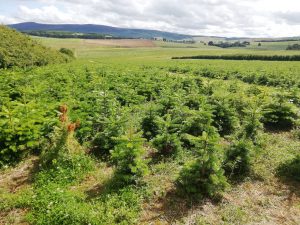
Figure 1: A monocultural Christmas tree plantation in Aberdeenshire – is this still to be called an “ecosystem” and a “forest”? (Copyright: SH).
Whilst afforestation on spared land seems generally a positive goal from an environmental perspective, it is important to clarify what kind of forests this implies. Typically, there are two types of uses and arguably, both are “useful” in their own way, but usually neither of them produces food: (1) Forests for logging, often in form of monoculture tree plantations that, in absence of an actual ecosystem, raise doubts whether they should be called “forests” at all (see Fig. 1). (2) Forests for conservation of “pristine” nature, rich in biodiversity. The latter also represents a major concern over Environmental Land Management schemes (ELMS), DEFRA’s schemes for post-EU land management, with both farmers and other stakeholders involved in food production fearing these schemes would fail to address food security issues by discouraging farming and food production in favour of promoting environmental stewardship and consequently aggravating the UK’s reliance on food imports.
This is where agroforestry represents a possibility going forward. What if we didn’t just create new logging plantations or natural reserves but multifunctional treescapes with edible species? That idea would follow conservation debates arguing against fortress-style conservation approaches and for a more “convivial” approach to conservation (Büscher & Fletcher 2019). More space for nature is vital, but does it have to be via an antinomy of increasing “pristine” or “museumified” natural reserves (Gobster 2007), on the one hand, and further intensification of how we exploit ecosystem services through agriculture, on the other? Conventional agriculture is outdated (yet the most common mode of food production) and a shift away from pesticides and synthetic fertilizers is long due, but what if the benefits of organic agriculture could even be further improved by centring it around trees that produce food? A shift away from high meat and dairy production could thus free up land that could be:
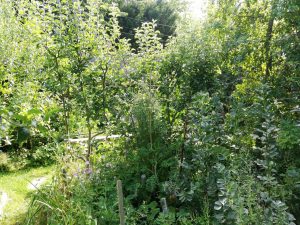
Figure 2: Dense forest garden of Garden Cottage, Coldstream, Scotland, with apple, hazelnut, and other trees, raspberry shrubs and other bushes, perennial and annual plants such as kale and broad beans and many more plant, animal, and fungi species (copyright: SH).
- reforested with trees mainly involving edible fruit and nut species with focus on trees that attract mycorrhizal fungi and provide (semi)wild space for foraging (also referred to as “food forestry” or “forest gardening”; see Fig. 2) = comparatively high tree density with trade-offs for mechanisation; and
- polycultural agroforestry systems with alley cropping, i.e. rows of tree crops and rows of annual crops that allow some degree of mechanisation without being monocultural (e.g. Wolz et al. 2017; see Fig. 3) = comparatively low tree density with greater applicability of mechanisation.
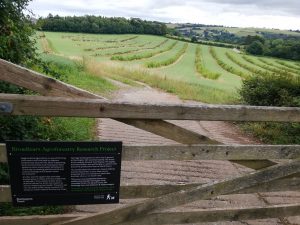
Figure 3: An example of alley cropping at the Dartington Trust near Totnes, Devon, UK (copyright: SH).
To better understand why this might be a worthwhile pathway towards sustaining society, there are four dimensions that illustrate the combined benefits of agroforestry systems:
Carbon sequestration – Trees and woody species contribute to carbon capture and storage in various ways. Carbon is stored in the biomass of plants. This includes aboveground vegetation, the parts of plants visible to us, but also the carbon stored belowground, in the roots. Falling leaves or twigs can be absorbed by the soil and turned into soil organic carbon (SOC). Trees also form symbiotic relationships with fungi which themselves store significant amounts of carbon in their mycelium. Nutrient exchange between plants and fungi may also induce further plant growth. Even logging can result in a form of carbon storage, provided that harvested wood is not burnt or left to decay in other ways but used in construction, e.g. of houses or furniture, where it is then stored on long term (while regrowth of trees is reassured). Last but not least, there may be indirect mitigation effects if food provision increasingly relies on edible woody species and edible fungi and, thereby, reduces the need to produce food by conventional means, i.e. monocultural agriculture and conventional feed crops for livestock in particular.
Biodiversity restoration – First of all, woody species and perennials provide habitat for a greater variety of species compared to grazing land, let alone arable land for annual crops. Biological diversity comprises plants, wild animals, fungi and the life of the soil. Compared to agriculture, agroforestry systems have significantly more flowering resources vital to pollinators (Kay et al. 2018). Polyculture also provides a greater variety of crops, potentially cropping at different times of the year and thriving under different circumstances (which may be a challenge to highly mechanised food production but also manifests in resilience against crop failure).
Social benefits – (Agro)forestry landscapes are attractive and can generate eco-tourism and be beneficial for local recreation and sports. They can be destinations for educational visits or sites for educational institutions such as forest kindergartens. Their benefits include an aesthetic value, contributing to physiological relaxation and cultural experience. They can be sites of cultural heritage, for example, by conserving or restoring traditional agroforestry systems that involve specific landscapes and human-nature relations (e.g. Montado landscapes in Spain; Laporta et al. 2021). Or, of course, they could also be sites for convivial eco-social experimentation beyond traditional human-nature relations.
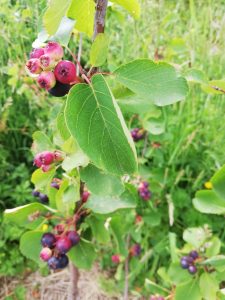
Figure 4: Juneberry (Amelanchier Saskatoon) growing at Tap O’ Noth Forest Garden Farm, Aberdeenshire, Scotland.
Food production – The presence of trees can improve the intra-actions in the soil such as mutualistic interactions between plants and microbes and between trees or plants and fungi, contributing to mediation of nutrient competition. Trees and shrubs create windbreak barriers that can protect other (e.g. annual) crops. Of course, fruit and nut trees and shrubs can themselves yield crops (see Fig. 4), but also provide habitat for other edible perennial plants and mushroom species. Dense food forestry or forest gardening is based on mimicking natural processes but the resulting treescapes and ecosystems are based on initial design and small interventions. Ideally, they involve “designs with shade-tolerant plants, good spacing, and the placement of plants with increasing heights from the south toward the north […] reducing light competition” (Bjorklund et al. 2019: 1116).
Polycultural agroforestry systems combine the benefits of carbon sequestration with food production, biodiversity and conservational goals, and the general social need to “reconnect” with nature in various ways. Thus, they provide multiple benefits that the dominant food provision paradigm of monocultural agriculture simply cannot. Organic agriculture surely challenges some of the disservices of conventional, intensive agriculture (e.g. in terms of soil health or excessive fossil fuel input) but often remains largely monocultural rather than managing its land as an ecosystem. The inclusion of woody, edible species appears to lift the multifunctional benefits to another level. While agroforestry is a practice that is older than agriculture, the design of these food forestry landscapes is an opportunity for “modern” food provision, and it can well be supported by technologies such as the inoculation of trees with edible fungi species (e.g. Guerin-Laguette 2021, Thomas & Vazquez 2021) to design “semi-wild”, biodiverse, polycultural, edible treescapes. Abandoning agriculture (as we know it) by conjoining agroecological growing methods with edible woody species and perennials would be no less than a theoretical and practical paradigm shift. Enriching agricultural grazing and arable land with alleys of woody species would indeed mean to “abandon” agriculture while optimising the multiple ecosystem services agroforestry systems can provide, including regenerative forms of food production.
According to The England Trees Action Plan 2021-2024 (p. 10), the UK government has already identified the need of planting 30,000 hectares of woodland per year. So why not plant species that yield crops? Indeed, “The Committee on Climate Change recommends that agroforestry should be used on at least 10% of arable land and grassland by 2050 to meet net zero” (ibid., p.22). Considering the multiple benefits we outlined, we wonder whether this recommendation is ambitious enough. Agroforestry is a spectrum from more conventional forms such as alley cropping, compatible with mechanisation, to denser, “semi-wild” food forestry. We see high potential in using some form of agroforestry on 100% of arable land and grassland by 2050 – to meet net zero and build resilience of the UK food system for its human and nonhuman beneficiaries.
This blogpost draws on two recent research projects the lead author conducted with various colleagues at the SCI and MERI: (1) “Optimising socio-environmental benefits of urban and peri-urban agriculture” funded by the UMRI (Dr Steffen Hirth, Prof David Johnson, Dr Jo Mylan, Dr Clare Robinson, and Dr Filippo Oncini) and (2) “Towards net zero foodscapes: Innovative ways to reduce land use trade-offs between mitigation, conservation, and agriculture” funded by the Faculty Research Recovery fund (Dr Steffen Hirth, Mr Ivan Drlička, and Prof Mat Paterson).
References
Bjorklund, J., Eksvard, K., Schaffer, C., 2019. Exploring the potential of edible forest gardens: experiences from a participatory action research project in Sweden. Agroforestry Systems 93, 1107–1118. https://doi.org/10.1007/s10457-018-0208-8
Büscher, B., Fletcher, R., 2019. Towards Convivial Conservation. Conservation and Society 17, 283. https://doi.org/10.4103/cs.cs_19_75
Clark, M.A., Domingo, N.G.G., Colgan, K., Thakrar, S.K., Tilman, D., Lynch, J., Azevedo, I.L., Hill, J.D., 2020. Global food system emissions could preclude achieving the 1.5° and 2°C climate change targets. Science 370, 705–708. https://doi.org/10.1126/science.aba7357
Gobster, P. H., 2007. Urban park restoration and the “museumification” of nature. Nature and Culture 2 (2), 95-114.
Hirth, S., 2022. Stockfree’s Short Shadow: Shifting Food Systems Towards Sustainability by Re-Thinking Veganism as a Performative Practice of Production, in: Tallberg, L., Hamilton, L. (Eds.), The Oxford Handbook of Animal Organization Studies, Oxford Handbooks. Oxford University Press, Oxford, New York, pp. 300–312.
Independent Review (2020) National Food Strategy: Part One, London: Defra.
Kay, S., Crous-Duran, J., de Jalon, S., Graves, A., Palma, J., Roces-Diaz, J., Szerencsits, E., Weibel, R., Herzog, F., 2018. Landscape-scale modelling of agroforestry ecosystems services in Swiss orchards: a methodological approach. Landscape Ecology 33, 1633–1644. https://doi.org/10.1007/s10980-018-0691-3
Weis, T., 2013. The Ecological Hoofprint: The Global Burden of Industrial Livestock. Zed Books, London.
Laporta, L., Domingos, T., Marta-Pedroso, C., 2021. It’s a keeper: Valuing the carbon storage service of Agroforestry ecosystems in the context of CAP Eco-Schemes. Land Use Policy 109. https://doi.org/10.1016/j.landusepol.2021.105712
Sun, Z., Scherer, L., Tukker, A., Spawn-Lee, S.A., Bruckner, M., Gibbs, H.K., Behrens, P., 2022. Dietary change in high-income nations alone can lead to substantial double climate dividend. Nature Food 3, 29–37. https://doi.org/10.1038/s43016-021-00431-5
Thomas, P.W., Vazquez, L.-B., 2022. A novel approach to combine food production with carbon sequestration, biodiversity and conservation goals. Science of The Total Environment 806, 151301. https://doi.org/10.1016/j.scitotenv.2021.151301
Willett, W., Rockström, J., Loken, B., Springmann, M., Lang, T., Vermeulen, S., Garnett, T., Tilman, D., DeClerck, F., Wood, A., Jonell, M., Clark, M., Gordon, L.J., Fanzo, J., Hawkes, C., Zurayk, R., Rivera, J.A., De Vries, W., Majele Sibanda, L., Afshin, A., Chaudhary, A., Herrero, M., Agustina, R., Branca, F., Lartey, A., Fan, S., Crona, B., Fox, E., Bignet, V., Troell, M., Lindahl, T., Singh, S., Cornell, S.E., Srinath Reddy, K., Narain, S., Nishtar, S., Murray, C.J.L., 2019. Food in the Anthropocene: the EAT–Lancet Commission on healthy diets from sustainable food systems. The Lancet Commissions 393, 447–492. https://doi.org/10.1016/S0140-6736(18)31788-4
Wolz, K., Lovell, S., Branham, B., Eddy, W., Keeley, K., Revord, R., Wander, M., Yang, W., DeLucia, E., 2018. Frontiers in alley cropping: Transformative solutions for temperate agriculture. Global Change Biology 24, 883–894. https://doi.org/10.1111/gcb.13986




0 Comments